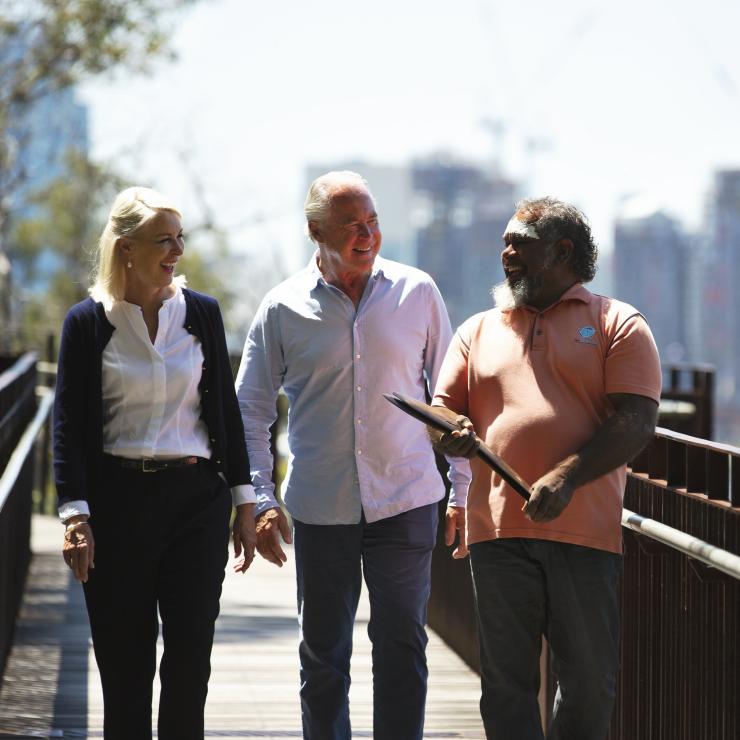Here’s how to engage with Aboriginal culture without leaving Western Australia’s capital.
By Fleur Bainger
Spend time with the Noongar Aboriginal people, the original inhabitants of the land Perth sits on, and you’ll gain a deeper understanding of the place you’re visiting. Take an entertaining walking tour through the city with a Noongar guide to hear stories of the ancient meeting the modern world. Or explore the city at your own pace as you learn about the deep spiritual connection that Western Australia’s First Peoples continue to have with this land.
Take a Walk With a Traditional Owner

For thousands of years, Perth’s Kings Park was an important ceremonial and Dreaming area for Aboriginal communities. The nature reserve sits on the banks of the Swan River, less than a 10-minute drive from the skyscrapers in the heart of town, and it’s one of the largest inner-city parks in the world.
Nyungar Tours’ Kerry-Ann Winmar shares Whadjuk Yorga stories – tales of Noongar women of the Swan River plains – as she takes you along the park’s treetop walkway. Kings Park is home to more than 3,000 native plant species, and Kerry-Ann explains how some of these plants are used for traditional bush food and medicine. She also pauses at the Pioneer Women’s Memorial, where she tells rarely heard tales of Aboriginal women.
While you’re in Kings Park, you can also take the self-guided Boodja Gnarning Walk. You have the option of a 2.4-kilometre (1.5-mile) walk that highlights the trees traditionally used by the Noongar people to make tools and weapons and for spiritual purposes, or the wheelchair-friendly 1.8-kilometre (1.1-mile) Yorga Track, which focuses on women’s traditional roles of gathering food and medicines.
Peer Beneath Perth’s Pavement

Most of the time when we visit a new city, we don’t look beyond the surface of glass and steel. But Noongar guide Walter McGuire, of Go Cultural Aboriginal Tours and Experiences, takes you way back in time on his walking tours. Walter unveils Perth’s historic Aboriginal meeting and hunting grounds, sharing tales of generations of his own family to deliver a moving, personal story that spans centuries.
On his highly regarded walking tour though the city centre and the Elizabeth Quay precinct on the Swan River, Walter shows that native flowers can also be medicine, and teaches the area’s traditional names, having fun with tricky pronunciations and revealing the warmth inherent in Australia’s Aboriginal people.
Discover The Depth of Aboriginal Art

In Perth’s civic centre, the Art Gallery of Western Australia (AGWA) has a permanent Aboriginal art wing, Six Seasons, which is free to visit. The variety of Aboriginal art is illuminating. You might find two-metre-tall (6.5-feet) ceremonial poles and detailed aerial-view paintings of the land, as well as modern works such as intricate charcoal portraits, surrealist scenes and even a painted car door.
There is also an extraordinary collection of dot paintings detailing traditional Dreaming stories, such as those about the Rainbow Serpent creation spirit, and events such as lightning storms and bushfires.
Hear the Aboriginal Take on Earth’s Creation

Aboriginal Dreaming stories explain what happened during creation, when the Earth and ancestral spirits came to be. Passed down over tens of thousands of years, they are central to Aboriginal beliefs and often relate astonishingly closely to modern-day scientific explanations.
Wadjuk man Justin Martin, of Djurandi Dreaming, shares his culture’s historic insights as he leads a Dreaming in the Quay night tour around the Elizabeth Quay waterfront precinct. Justin links past and present as he leads tours across the river’s pedestrian bridge, interpreting public Aboriginal artworks using his specialist art knowledge.
Think Inside the Square

Aboriginal culture is a living part of everyday life in Perth. One of the city’s busiest pedestrian zones, Yagan Square, centres around Noongar culture. This public space, which opened in 2018, is dominated by a nine-metre-tall (30-foot) warrior sculpture that symbolises the cultural longevity of Aboriginal people.
A huge digital screen is held by columns inspired by the bulrushes that once edged the meeting-place lakes here, while the native wildflower garden signals the sacredness of nature for the world’s oldest living culture. Events, including performances and educational activities, are tied to the six-season Noongar calendar.



